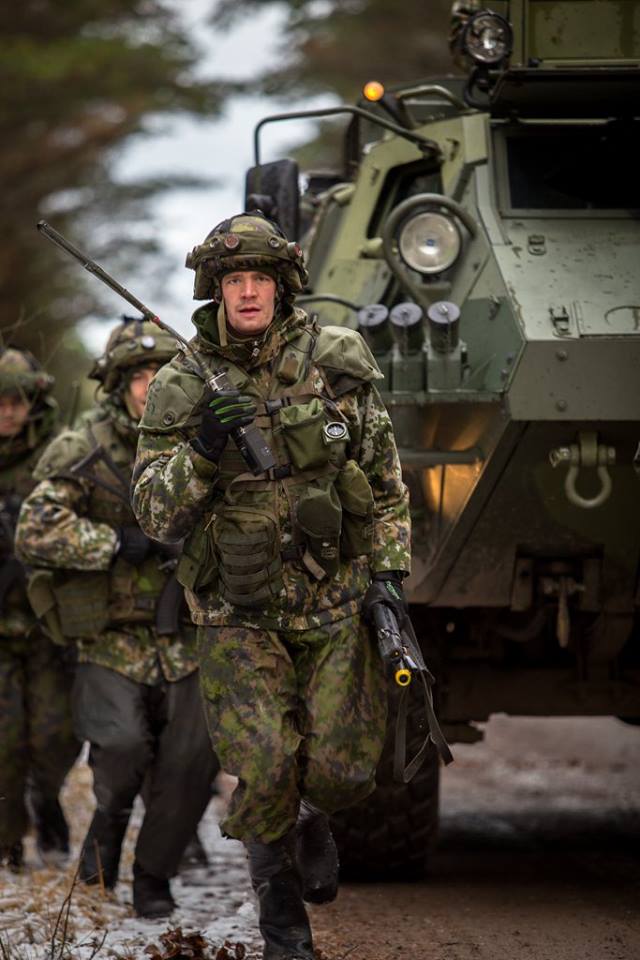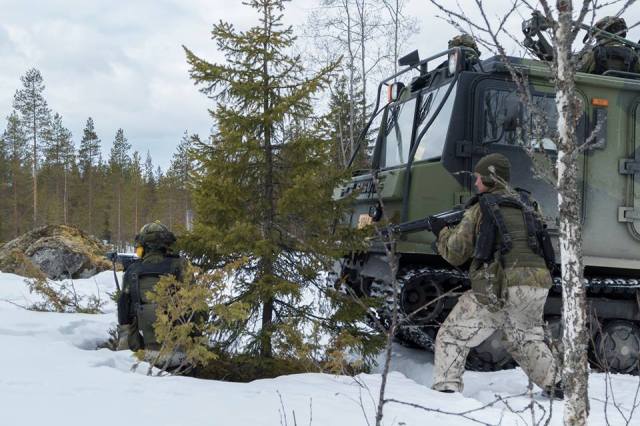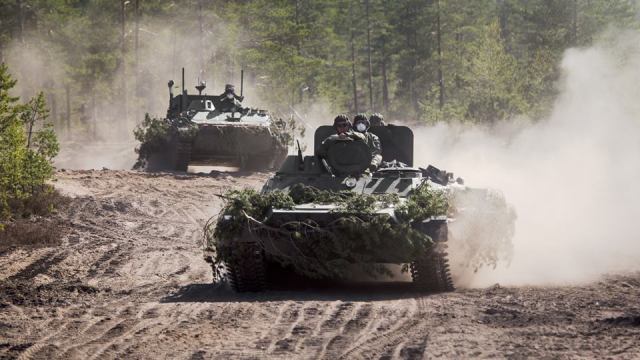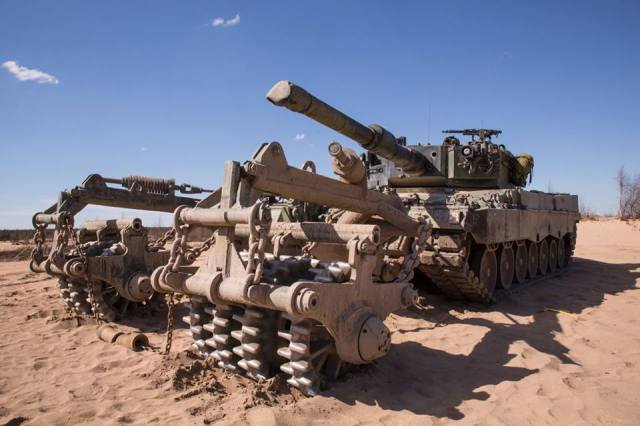ON
MAY 26, 2018 BY
CORPORAL FRISKIN
ARMY,
FINLAND
Edited some details 26 May 2018, 21:30
Welcome to the Finnish Army, sporting seven brigades and a 280,000 strong reserve.
Except neither is really correct.
The peacetime brigades (and brigade-sized regiments) are training units and would not deploy in the field in wartime, though they will oversee the mobilisation of the wartime units. The reserve is also around 900,000 strong, though the wartime strength to be mobilised is indeed the more oft-quoted 280,000. However, less well understood is the force composition.
Note: this whole post is based on open sources which are linked throughout. As the details of the topic is surrounded by secrecy and due to the rapid pace of recent developments in the Finnish Defence Forces, some figures are potentially obsolete.
Motorised infantry during exercise UUSIMAA17. Source: Maavoimat
The two main documents describing today’s wartime force is the
Finnish Security and
Defence Policy 2012 which established the ‘current’ organisation (with a wartime strength of 230,000), and the later
Government’s Defence Report 2017 which raised the strength to the current level. The former (FSDP12) describe the strategy:
The Army is the most important service in active defence and decisive battles.
Ground defence will hold up and gradually wear down the adversary, retain
control over key military areas, repel attacks, protect society’s vital functions
and targets and, ultimately, defeat the aggressor
To perform their mission the force is divided into three tiers (descriptions from GDR17):
- Manoeuvre or Operational forces create the centre of gravity of the defence and fight the decisive battles
- Regional forces are used for creating regional defence coverage
- Local forces participate in battle and provide security, surveillance and support to the manoeuvre and regional forces in their area and assist them in maintaining contact with the other authorities.
In addition some units are left outside of this organisation, being allocated directly to higher command and/or supporting functions distributed according to need. These are e.g. the Border Guard’s border jaeger and special border jager units, which are light infantry units specialising in operations behind enemy lines including intelligence gathering. Other capabilities are some high-end support functions, such as the certain artillery and air defence units.
The regional forces is your run-of-the-mill troops. These would be manning the frontlines, and while not necessarily featuring the latest when it comes to equipment nor being prioritised when it comes to deciding which units take part in refresher exercises, they still retain a certain amount of mobility to be able to follow the movements of the fighting. The key units here are three infantry brigades which are to be mobilised in wartime, and in addition the Navy will create three coastal battle groups (FSDP12). One of the notable changes which have been implemented is that the size of the infantry units have been increased throughout the ladder. The
infantry yearbook of 2013 provides a breakdown of a typical regional infantry battalion. Starting with the squad, it has been increased from eight to nine, with the platoon sporting three squads and a small staff including a transport section and artillery observers to number between 36 to 44 personnel. Both the individual squads and the platoon have also received more firepower in the form of added support weapons. The important change, however, comes at the ladders above, and include the shift from three to four platoons per company, and from three to four companies per battalion. The key driver here is to make the infantry units more resilient to losses. In other words, it is expected that the level of casualties in a future war will call for bigger units than has been the case up until now to make them able to maintain their combat ability. For its indirect fire needs, a battalion will have 12 heavy 120 mm mortars and 18 (towed) field guns/howitzers.
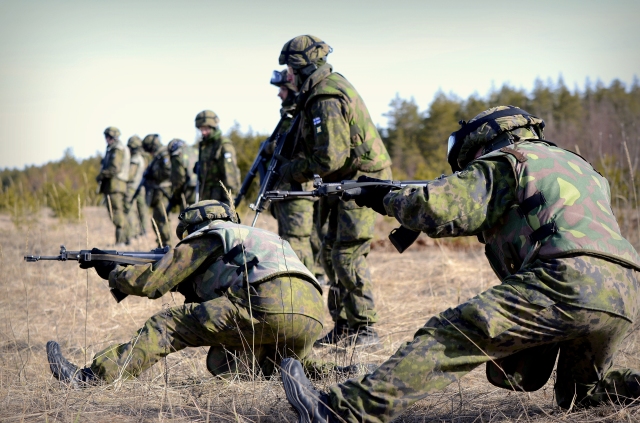
Reservists of Keski-Pohjanmaan Maakuntakomppania (the local volunteer company of central Ostrobothnia) stretching their legs during exercise PAUHA16 at the Vattaja exercise area. Picture courtesy of Jouko Liikanen
The local forces is a relatively new feature of the Finnish Defence Forces. A key factor is the increased fragmentation of the battlefield, meaning that it is not necessary clear where the frontline runs. Especially of concern in northeastern Europe is the emphasis placed by Russia on airmobile movement, both by special forces, VDV, and the marine infantry. This has further worsened what has traditionally been the Finnish achilles heel, in that Finland is a relatively large but sparsely populated country. To avoid having to dispatch regular units to guard rear areas potentially very far from any fighting, the local defence forces
Maakuntajoukot were created. These are voluntary units, generally companies tied to the region in which they are recruited. The voluntary and regional nature means that they are cheap, staffed by people that know each other from training together on a regular basis, and in wartime they would fight in terrain they know. This also makes them excellent for the envisioned liaison role between regional/operational forces and other authorities. On the flip side, their equipment needs are furthest down the pecking order, and the generally older personnel means that the physical fitness isn’t necessary on par with that of the younger reservists (though contrary to other reserve units there are yearly fitness tests which needs to be passed).
The tip of the spear is then made up of three readiness brigades, two mechanised battle groups,
two motorised battle groups, and one special forces battalion (FSDP12).
Edit: In a recent Jane’s interview Lt.Gen. Toivonen refers to the mechanised and motorised battle groups as one mechanised and one motorised brigade respectively, indicating that they have the chain of command ready to operate jointly as well. The Navy will also mobilise one coastal jaeger battle group, which is the sole Finnish unit destined for offensive operations in the archipelago. This means it uses boats to get around, with the exception of the
organic heavy indirect fire (120 mm mortars towed by trucks).
The jaegers of Kainuu Brigade in action during exercises a few years ago. Source: Maavoimat FB
The brigades are
not copies of each other. One is to be mobilised by Porin prikaati (the Pori Brigade), and will be wheeled with a core of the Army’s 60 Patria AMV 8×8 APC’s (as well as the 120 mm AMOS mortar version of the same vehicle) backed up by older XA-series 6×6 APC’s. Another will be set up by Karjalan prikaati (the Karelia Brigade), and will in turn be a tracked unit sporting the CV9030 as the main IFV. The chief difference between these two are obviously that the wheeled brigade sports better operational mobility and is better suited to the more open terrain towards the southwestern part of the country, while the tracked units sports better off-road mobility and vehicle mounted firepower. The final brigade is mobilised by Kainuun prikaati (the Kainuu Brigade), and is built for the wilderness dominating the northern parts of Finland. As such, it sports an unique mix of wheeled vehicles and tracked all-terrain vehicles. When fully mobilised a readiness brigade will sport a complement of around 5,600 personnel and 900 vehicles. To put this into perspective, the three peacetime units each train around 4,000 conscripts a year (in two batches) and hold between 500 and 700 full-time personnel. While the core of the wartime brigades are trained by their peacetime homes, several supporting functions such as air defence units are trained by other brigades and attached upon mobilisation.
The mechanised battlegroups are armoured battalions reinforced to be able to conduct independent operations. A rather detailed TOE from a number of years back is found at the
Armoured guild’s homepage, and a somewhat updated version is also found in a
presentation made by the Panssariprikaati (Armoured Brigade). Coupled with knowledge of the recent acquisitions and upgrades, it is possible to make a quite detailed picture of these elite units.
Following the (ongoing) introduction of the Leopard 2A6 into service, these will sport two armoured companies (totalling 29 Leos) and two mechanized infantry companies with
BMP-2M (50 vehicles). In addition, the unit has its own engineering company (including Leopard 2L bridging tanks and Leopard 2R mine-clearing tanks), air defences (including Marksman 35 mm SPAAGs on Leopard 2A4 hulls), as well as mortars and self-propelled guns. In total the battle groups will have 200+ armoured vehicles, another 350 wheeled vehicles, and almost 2,300 personnel. This is the armoured fist of the wartime Army.
MT-LBV and -LBu are still important vehicles for specialised roles in the mechanised battle groups and as the mainstay vehicles for the motorised battle groups. Here two vehicles in action during exercise ARROW18. Source: Maavoimat FB
The motorised battle groups are roughly modeled according to the same mould, but their three infantry companies travel in the venerable MT-LBV. A crucial change compared to the older TOE’s, is that the motorised units
have received Leopard 2A4 following the introduction of the 2A6, which means they now have organic tank support,
with a single company per battlegroup. The battle groups can be used either together with the other readiness units, or then independently. While it can be used on the offensive, compared to the other units it is especially well-suited for “
active defence“. For those who want to understand how the Finnish Army want to execute active defence, the official Defence Forces YouTube-channel has an
illustrative video (English subtitles) depicting a battalion out of the PORPR readiness brigade defending against a mechanised enemy.
But what about Finland’s older tanks? The T-72M1’s have all been scrapped over a decade ago, following the acquisition of the Leopard 2A4’s. However, the even older T-55M’s still survive in limited numbers, mainly for use as training vehicle for units needing to train with or against tanks, such as mechanised infantry or anti-tank units. However, with the arrival of the Leopard 2A6 freeing up the 2A4 to the training role the days of the T-55 are limited, although they do still appear at exercises every now and then. A number of engineering versions also live one, mainly the BLG-60M2 bridging version and tanks equipped with the KMT-5M mine rollers, but here as well the increased number of Leopard 2L and 2A4’s with Urdan mine rollers will likely be felt.
A Leopard 2A4 fitted with Urdan mine rollers taking part in exercise ARROW16. The mine rollers provide a level of mine clearing ability while maintaining the combat ability of the 2A4. Source: Maavoimat FB
Following cannibalisation and conversions to supporting vehicles the number of operational Leopard 2A4’s are likely somewhere between 80 and 100, and together with potentially some T-55’s the remaining ones are grouped into
independent armoured companies. These can then be distributed according to need, though it is safe to assume that the readiness brigades will receive the bulk of them. The heavily forested nature of Finland means that combat distances are usually short, which
can prove troublesome both for anti-tank missiles and for trying to maneuver large armoured units. The theory is that this makes smaller armoured units effective in the anti-tank role, though naturally any notion that dispersed armour would be effective usually causes heated debate. “
Man schlägt jemanden mit der Faust“, und so weiter.
This leaves one odd bird, namely the newly created Readiness Units (
Fi. valmiusyksiköt). These are the
mixed battle groups made up of currently serving conscripts and professionals which are to be able to take to the field immediately and buy enough time for the ‘proper’ wartime units to mobilise. What will happen after that is a bit unclear, and as far as I am aware of this has never been publicly discussed. Likely the companies will be integrated into the brigades mobilised by their parent units, though it can be questioned whether they will be able to immediately transfer into the regular chain of command or whether they will have taken such losses in the initial onslaught that they will have to be sent back for replenishment before they can be transferred to a brigade.



